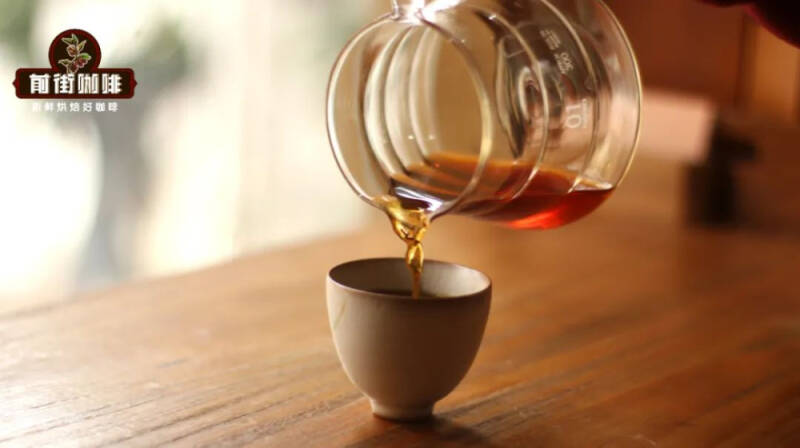Is coffee sweet and sweet the same thing?

"Huigan Shengjin, bitterness comes" is the highest praise for a good cup of tea, and in the taste of coffee, people often use the word "Huigan", which often refers to the pleasing taste of coffee. So, what kind of taste experience is it when you taste sweet coffee in the middle? What's the difference between it and the sweetness of coffee?

After the coffee is swallowed, the aroma, taste and taste of the coffee substances left in the mouth are called Yuyun. Before swallowing, the taste, aroma and touch of coffee are classified as flavor and taste, while these characteristics of coffee after swallowing are called Yuyun, which can be simply understood as a matter of time lag. In this way, when tasting the coffee in the future, we can judge which part belongs to the flavor and which part belongs to the aftertaste according to this period of time.
Yu Yun is usually divided into two types: positive and negative. Good coffee naturally has a positive aftertaste, such as flower aroma, fruit sweetness, tea rhyme, honey, etc., while Huigan belongs to the positive aftertaste, while the negative aftertaste is common in the taste of dirt, rubber, sawdust and other tastes. And dry, rough, stuck throat and other unpleasant taste.
In addition to looking at the quality, we also depend on the duration of the aftertaste. The longer the good flavor stays, the better the performance of the aftertaste. For example, after drinking a cup of warm sun espresso, the remaining fermentation and cocoa aroma in the mouth will last for ten minutes, while the short Italian flavor will disappear within seconds even if there is no negative taste.
Next, let's take a closer look at Huigan's performance. A taste bud experience in which the coffee is slightly bitter or sour, then the sweetness gradually exceeds the bitter (sour) astringency, and finally ends with sweetness. The so-called "bitter before sweet" is the sweet smell that comes back after the bitter taste dissipates in the mouth. For example, the oil mandarin from Chaoshan, the first bite is to feel the stimulation of the sour, slightly astringent tongue, and then the mouth begins to give birth to fluid, while full of sweet taste.
Thus it can be seen that the Hui Gan de here is based on the taste shown by bitterness or astringency to a certain extent. Unlike the sweetness directly felt when eating candy, it must have experienced "bitterness" and set off by "bitterness" before it can be called "Huigan". However, it should be noted that there is no inevitable relationship between the degree of bitterness and the intensity of sweet beverage. a cup of coffee may be very bitter, but it may not be sweet.
When we evaluate bitter deep-roasted coffee beans, Huigan is a good indicator. For example, when tasting Brazilian Queen's Manor coffee in Qianjie, it first tastes bitter like fried peanuts and dark chocolate, then the bitterness begins to fade, accompanied by a sweet taste, and it lasts for a period of time. It can be called having a good return to sweet taste.
Nowadays, many coffees take shallow roasting techniques, highlighting the fragrance of flowers and rich acidity, but also less mellow and solid bitterness. Most of the coffee is made of small molecules, hydrophilic, volatile, and rich in organic acids, which promote saliva secretion, thus speeding up the loss of flavor. This is why when drinking light roasted coffee, the aftertaste is often not as strong and lasting as deep roasted coffee.
For this reason, rather than the word "Huigan", baristas prefer to combine its aftertaste in the mouth and sweet and sour aftertaste to describe the aftertaste of this kind of flower-and-fruit flavor coffee. For example, when Pokuit is washed in Qianjie Cup, the remaining rhyme will be described as the tea rhyme of Tieguanyin, the tangerine acidity of sugar and the sweetness of honey.
Finally, Qianjie noticed a phenomenon that some friends interpreted the sweetness of drinking water after drinking coffee as returning sweet. In fact, this is a kind of oral illusion caused by sensory contrast under the impact of bitterness. Because sweetness and bitterness are relative concepts, when you taste sugar, you will find that water is somewhat bitter, and when you taste bitter coffee, you will think that water is sweet, and this phenomenon is a contrastive effect. Similarly, Huigan can also be understood as an illusion of the mouth under the impact of bitterness.
-END-
Front Street Cafe
No. 10 Baoqian street, Yandun road, Dongshankou, Yuexiu district, Guangzhou, Guangdong province
Important Notice :
前街咖啡 FrontStreet Coffee has moved to new addredd:
FrontStreet Coffee Address: 315,Donghua East Road,GuangZhou
Tel:020 38364473
- Prev

Introduction of coffee producing areas, coffee varieties and Manning coffee in Indonesia, a coffee producing country in Asia
Indonesia is a country in Southeast Asia, connected with Papua New Guinea, East Timor and Malaysia. It is made up of 17508 islands and is the largest archipelago country in the world, spanning Asia and Oceania, and is also a volcanic country. Indonesia is located in the tropics, the climate is warm and humid all the year round, and the average temperature
- Next

Number one in the world! The number of coffee shops in China surpasses that of the United States.
Recently, World Coffee Portal, a research organization owned by Allegra Group, released the latest annual report on the coffee market in East Asia. China has overtaken the United States to become the country with the largest number of branded coffee shops in the world, according to the report. There are about 120000 people in East Asia.
Related
- What effect does Italian American coffee with filter paper have? Will coffee taste better if it is put on filter paper at the bottom of the powder bowl?
- What is the color difference in coffee beans? What are the characteristics of honey processed coffee beans? Why are the anaerobically treated coffee beans uneven in color?
- How does novice Xiaobai quickly get started and make coffee? Newbies learn to make coffee by hand and share the specific steps and process process!
- Costa tea has a shelf life of 100 years?! Expert: Unable to verify
- It's a huge uproar! American milk addition was rejected by Manner employees?!
- Mocha pot coffee bean recommendations| How fine and how much powder should be used for grinding? What parameter ratios do I need to use to make milk with Mocha pot coffee?
- What are the characteristics of the world's top ten coffee beans treated with Costa Rica honey? How to make black honey kadura from Tarazhu Pilon Processing Plant taste good?
- How to make deep-roasted coffee? What grinding water temperature does authentic Jamaica Blue Mountain No. 1 coffee use to brew it well?
- Selected high-grade rose summer coffee flavor tasting guide Why Panama rose summer has the aroma of flowers and fruits
- What equipment does a novice Xiaobai need to buy to learn to make coffee? Filter cup electronic scale bean grinder manual flushing pot purchase guide

